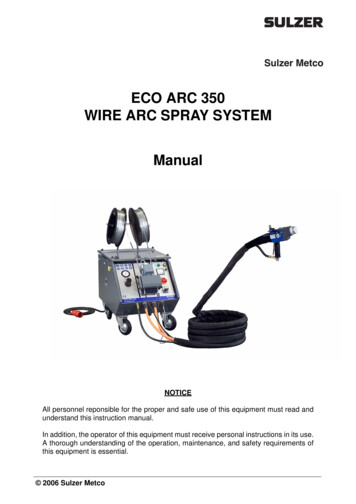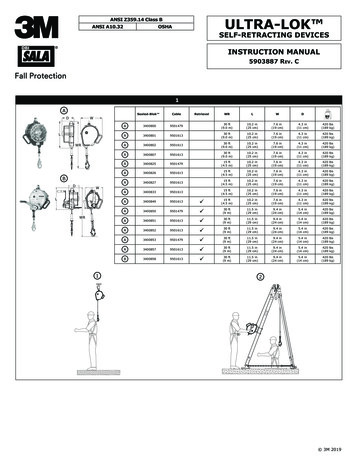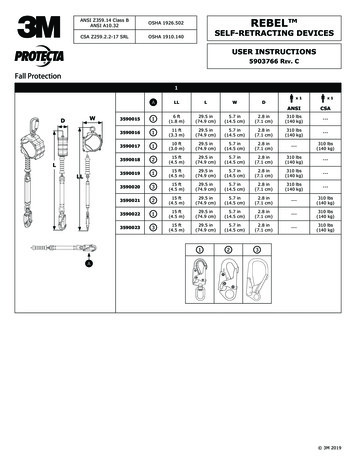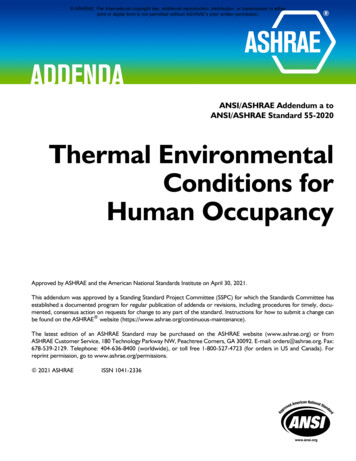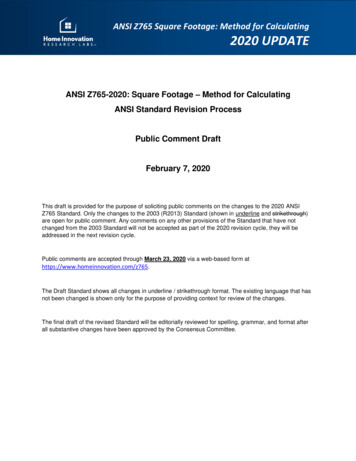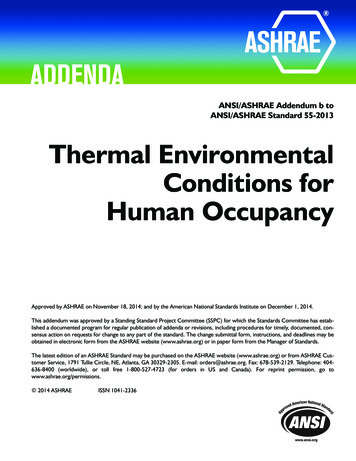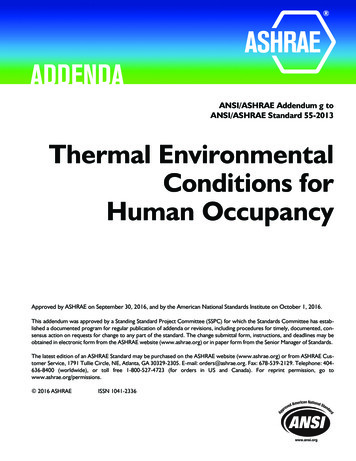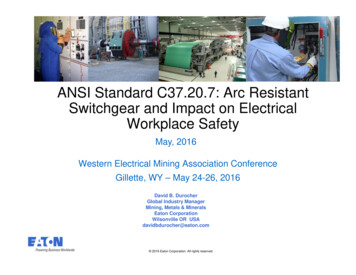
Transcription
ANSI Standard C37.20.7: Arc ResistantSwitchgear and Impact on ElectricalWorkplace SafetyMay, 2016Western Electrical Mining Association ConferenceGillette, WY – May 24-26, 2016David B. DurocherGlobal Industry ManagerMining, Metals & MineralsEaton CorporationWilsonville OR USAdavidbdurocher@eaton.com 2016 Eaton Corporation. All rights reserved.
Short Infomercial – IEEE IASIEEE Industry Applications Society: Mining Industry Committee Meeting in the fall at theIAS Annual MeetingTypically two sessions ofpapers (one day)Perhaps consider aWMEA co-located eventin the future22
OverviewWhat you will learn from today’s session? Review arc flash events and electrical workplace safety standards Become familiar with the ANSI/IEEE Standard C37.20.7 Understand the differences between arc-resistant switchgear andnon arc-resistant switchgear Understand the testing requirements for arc-resistant switchgear Overview relative costs of standard versus arc-resistant switchgear Comparing other technologies available that reduce arc flash energy Application considerations in determining what should be specifiedfor process industries33
Review of Arc Flash HazardsAn Arc Flash - An electrical arc due to either aphase to ground or phase to phase fault. Causedby many factors - dropped tools, improper workprocedures, etc. 80 percent of all electrical injuries are burnsthat result from the electric arc flashArc flashes cause electrical equipment toexplode, resulting in an arc-plasma fireballSolid copper vaporizes, expands to 67,000times its original volumeTemperatures exceed 19,000 degrees CDetected sound levels of 141.5 decibelsPressure levels of 10,540 Kg per squaremeterArc Flash & PPE44
Standards Addressing Arc Flash HazardsElectrical Workplace Safety NFPA70E-2015 Standard for Electrical Safety in theWorkplace: (US) and CSA Z462-2015 (Canada) Quantifies Heat Energy from arc flash in calories/cm2Recommends fire rated clothing: Personal ProtectiveEquipment (PPE) used during energized workRecommends study update every 3 yearsArc Flash Calculations IEEE 1584-2002 “Guide for Performing ArcFlash Calculations” It presents formulas for numericallyquantifying heat energy from arc-flashIncludes an Excel Spreadsheet “Arc-FlashHazard Calculator” that performs calculationsusing heat energy formulas55
ANSI/IEEE Standard C37.20.7“Guide for Testing Metal-EnclosedSwitchgear Rated Up to 38kV forInternal Arcing Faults” First Issued in 2001Co-published by (ANSI) AmericanNational Standards Institute and the(IEEE) Institute of Electrical andElectronics EngineersThird-party testing required based on(UL) Underwriter’s LaboratoriesApplies to North America switchgear assemblies66
ANSI/IEEE Standard C37.20.7“Guide for Testing Metal-Enclosed SwitchgearRated Up to 38kV for Internal Arcing Faults”1.1 ScopeThis guide establishes methods by which metal-enclosed switchgear, as defined byIEEE Std C37.20.1-2002, IEEE Std C37.20.2-1999, and IEEE Std C37.20.3-2001, may betested for resistance to the effects of arcing due to an internal fault. This guide appliesonly to equipment utilizing air as the primary insulating medium and rated up to 38 kVac. It applies to both indoor and outdoor equipment; however, special consideration must begiven to the building size and construction for indoor applications (not addressed by thisdocument).The Scope of this Standard includes “switchgear” as defined by: IEEE Standard C37.20.1 Low-Voltage Metal Enclosed SwitchgearIEEE Standard C37.20.2 Medium-Voltage Metal-Clad SwitchgearIEEE Standard C37.20.3 Medium-Voltage Metal-Enclosed Switchgear77
LV Switchgear: ANSI/IEEE Standard C37.20.1-2002“IEEE Standard for Metal-EnclosedLow-Voltage Power Circuit BreakerSwitchgear” First Issued in 1987Co-published by (ANSI) AmericanNational Standards Institute and the(IEEE) Institute of Electrical andElectronics EngineersThird-party testing required based on(UL1558) Underwriter’s Laboratories88
LV Metal Enclosed SwitchgearDESIGN FEATURES: 600V Class Switchgear: ANSI/IEEE C37.20.1 Ratings through 600Vac, 100kA,5000AUtilizes low-voltage drawout powercircuit breakers, 800 through 5000AFour circuit breakers per panelRequires rear access for load cableterminationsLow-Voltage Metal-EnclosedSwitchgear99
LV Metal Enclosed SwitchgearDESIGN FEATURES: 600V Class Switchgear: ANSI/IEEE C37.20.1Breaker LifterFrontBKR 192.0”(2337)BKR 2CableCompartmentBusCompartmentBKR 3BreakerCompartmentBKR 4Low-Voltage Metal-EnclosedSwitchgear72.0” (1828.8)Side View (Rear AccessAssembly)1010
MV Switchgear: ANSI/IEEE Standard C37.20.2-1999“IEEE Standard for Metal-CladSwitchgear” First Issued in 1987Co-published by (ANSI) AmericanNational Standards Institute and the(IEEE) Institute of Electrical andElectronics EngineersThird-party testing required based onIEEE Std 4-1995 “StandardTechniques for High-Voltage Testing”1111
MV Metal-Clad Switchgear5/15kV Class MV Switchgear: ANSI/IEEE C37.20.2 Medium Voltage Metal-Clad SwitchgearRatings at 5/15kV up to 38kV,63kA, 4000AUtilizes medium-voltage drawoutvacuum circuit breakers, 1200Athrough 4000ATwo circuit breakers per panel“Metal-Clad” means groundedsteel barriers isolating breaker,bus and cable compartmentsRequires rear access for loadcable terminations1212
MV Metal-Clad Switchgear5/15kV Class MV Switchgear: ANSI/IEEE C37.20.2BusCompartmentFrontBKR R 2Medium Voltage Metal-Clad Switchgear96.25” (2445)Side View (Rear Access Assembly)1313
MV Switchgear: ANSI/IEEE Standard C37.20.3“IEEE Standard for Metal-EnclosedInterrupter Switchgear” First Issued in 1987Co-published by (ANSI) AmericanNational Standards Institute and the(IEEE) Institute of Electrical andElectronics EngineersThird-party testing required based onIEEE Std 4-1995 “StandardTechniques for High-Voltage Testing”1414
MV Metal-Enclosed Switchgear5/15kV Class MV Interrupter Switchgear: ANSI/IEEE C37.20.3 Ratings at 5/15kV up to 38kV,61kA, 1200AUtilizes medium-voltage loadbreak switch with current-limitingfuse, 600A or 1200AOne switch/fuse per panelRequires rear access for loadcable terminationsMedium Voltage Fused Load-InterrupterSwitchgear1515
MV Metal-Enclosed Switchgear5/15kV Class MV Interrupter Switchgear: ANSI/IEEE C37.20.394.1”(2390)Medium Voltage Fused Load-InterrupterSwitchgear71.25” (1810)Side View (Rear Access Assembly)1616
ANSI/IEEE Standard C37.20.7“Guide for Testing Metal-Enclosed SwitchgearRated Up to 38kV for Internal Arcing Faults”5.3 Arc InitiationFor equipment defined by IEEE Std C37.20.1-2002: The arc shall be initiated by means of ametal wire 2.6 mm in diameter or 10 AWG.For equipment defined by IEEE Std C37.20.2-1999 and IEEE Std C37.20.3-2001: The arcshall be initiated by means of a metal wire 0.5 mm in diameter or 24 AWG.Arc initiation via a metal wireconnected across all three phases1717
ANSI/IEEE Standard C37.20.7“Guide for Testing Metal-Enclosed SwitchgearRated Up to 38kV for Internal Arcing Faults”4.3 Arcing durationThe rated arcing duration is the period of time the equipment can experience the effects of aninternal arcing fault and meet the requirements specified by this guide in 6.1. Where the durationis limited by protective devices, those devices shall be identified on the equipment nameplate.See 5.2.5 for testing with device-limited duration and 6.3 for nameplate marking.The preferred rated arcing duration is 0.5 s.Although any value of rated arcing duration is permitted, the minimum recommend duration is0.1 s. It is generally considered unnecessary to test for durations longer than 1.0 s.Arc Duration: “Preferred” at 0.5 seconds but minimum of 0.1 seconds1818
ANSI/IEEE Standard C37.20.7“Guide for Testing Metal-Enclosed SwitchgearRated Up to 38kV for Internal Arcing Faults”4.1 Accessibility typeA distinction is made between two levels of accessibility to switchgear assemblies. Theselevels correspond directly to the indicator placement given in 5.4.2.Type 1 - Switchgear with arc-resistant designs or features at the freely accessible front of theequipment only.Type 2 - Switchgear with arc-resistant designs or features at the freely accessible exteriorfront, back, and sides) of the equipment only.“Type” designations define arc protection from the front of theswitchgear only (Type 1) or from all sides (Type 2)1919
ANSI/IEEE Standard C37.20.7“Guide for Testing Metal-Enclosed SwitchgearRated Up to 38kV for Internal Arcing Faults”A.2 Suffix “B”This suffix is designated for equipment where normal operation of the equipment involvesopening the door or cover of compartments specifically identified as low-voltage control orinstrumentation compartments.A.3 Suffix “C”This suffix is designated for equipment where isolation from the effects of an internal arcing faultis desired between all adjacent compartments within a switchgear assembly.A.4 Suffix “D”This suffix is designated for equipment specifically designed for installations where someexternal surfaces of the equipment are inaccessible and no need exists to use a Type 2 design.“Suffix” categories define arc performance for control compartmentsand between vertical sections2020
ANSI/IEEE Standard C37.20.7“Guide for Testing Metal-Enclosed SwitchgearRated Up to 38kV for Internal Arcing Faults”5.4 Indicators (for observing the thermal effects of gases)Indicators are constructed from pieces of black cotton fabric arranged so that the cut edges do not point toward the test sampleand each indicator is isolated from the others to prevent multipleignitions from a single source. The frame shall be mounted withthe frame sides perpendicular to the plane of the test sample and thefabric parallel to the plane of the test sample. The dimensions of theexposed fabric are to be 150 mm 150 mm (–0, 15 mm) (6 in 6in). Refer to Figure 1 for indicator assembly dimensions.Vertical indicators are to be located from floor level to a height of 2 m(79 in) from the floor and at a distance of 100 mm 15 mm (4 in.)from the surface of the cloth to the switchgear.Horizontal indicators are to be located at a height of 2 m (79 in) fromthe floor and horizontally covering the whole area between 100 mm 15 (4 in) and 800 mm (31 in) from the test sampleTest design to assure cotton indicators do not ignite2121
Arc-Resistant Switchgear (ANSI C37.20.7)Arc Rated ANSI/NEMA/IEEE Standard C37.20.2 Medium-VoltageMetal-Clad SwitchgearArc FlapsControlSectionVT drawer1200A can be 1high or 2 high2000A or 3000A breakerwith Vent15 kV Arc Resistant SwitchgearRedirects Arc Energy and Particulates2222
Arc-Resistant Switchgear – Type 2C ConstructionANSI/IEEE C37.20.2 Switchgeartested to ANSI/IEEE C37.20.7 ArcResistant Standard – Type 2C 4Each of eight compartments is isolatedInitiating an arc event in compartment4 will not propagate to adjacentcompartments or vertical sectionsGasses will be vented up through theplenum 2 meters above the floor level1762853 Arcing fault incompartment 42323
MV Metal Enclosed Motor Control Centers7.2kV Class Motor Control Center, tested to ANSI/IEEE C37.20.7 ArcResistant Standard – Type 2B Ratings through 7.2kV, 30kA and50kA, 0.5 seconds, 3000A bus Type 2B TestUtilizes fused isolation switch andvacuum contactor, 400 and 800A Two starters per panel Front access design Option: Arc Resistant design tested toANSI/IEEE C37.20.7UL 347 standard to complete the draftannex for arc resistant MV MCCsArc Resistant Medium-Voltage MCC2424
MV Metal Enclosed Motor Control Centers7.2kV Class Motor Control Center, tested to ANSI/IEEE C37.20.7 ArcResistant Standard – Type 2BType 2B TestArc Resistant Medium-Voltage MCC123.6”(3140)52.25” (1327)Side View (Front Access Assembly)2525
LV Metal Enclosed Motor Control CentersDESIGN FEATURES: 600V Class Motor Control Center: UL845 Standard Ratings through 600Vac, 100kA,5000AUtilizes low-voltage molded casecircuit breakers and starters, 50through 4000A Typically six starters per panel Front access designANSI C37.20.7 does not apply!Recommend CSA C22.2.022Low-Voltage Metal-Enclosed MCC2626
IEC StandardsMedium-Voltage is certified in accordance with:IEC 62271-1Common specificationsIEC 62271-100Circuit-breakers (E1/E2, M2, C2)IEC 62271-102Disconnectors and earthing switches (E2, M0)IEC 62271-200Metal enclosed switchgear and controlgearIEC 60044-1Current transformersIEC 60044-2Voltage transformersIEC 60529Degrees of protection (IP Code)Low-Voltage is certified in accordance with:IEC 61439Switchgear and control gear systemsIEC 60947-1Breaker and Control general rulesIEC 60947-2Circuit-breakersIEC 60947-3Switches, disconnectors and switch-disconnectorsIEC 60947-4Contactors and motor startersIEC 60529Degrees of protection (IP Code)2727
IEC 62271-200: Definition & Test CriteriaDEFINITION: Internal Arc Classified switchgear and controlgear (IAC)Metal-enclosed switchgear and controlgear for which prescribed criteria for protection ofpersons are met in the event of internal arc as demonstrated by the appropriate testsTEST CRITERIA Criterion No. 1: Correctly secured doors and covers do not open.Deformations are acceptable, provided no part comes as far as theposition of the indicators or the walls. Criterion No. 2: No fragmentation of the enclosure occurs within thetime specified for the test. Projections of small parts up to 60 g areaccepted Criterion No. 3: Arcing does not cause holes in the accessible sidesup to a height of 2 meters. Criterion No. 4: Indicators do not ignite due to the effect of the hotgases. Criterion No. 5: The enclosure remains connected to it’s earthingpoint. Visual inspection is generally sufficient.2828
IEC 62271-200: Designation of IAC Classifications Example: IAC metal enclosed switchgear rated for 12.5kA, 0.5 seconds. Publicaccessibility from the rear, authorized personnel both front and lateral.Classification: IAC BR - AFLInternal Arc: 12.5kA, 0.5 seconds2929
Redirect Blast EnergyArc-Resistant/A
IEEE Standard C37.20.3 Medium-Voltage Metal-Enclosed Switchgear ANSI/IEEE Standard C37.20.7 1.1 Scope This guide establishes methods by which m etal-enclosed switchgear, as defined by IEEE Std C37.20.1-2002, IEEE Std C37.20.2-1999, and IEEE Std C 37.20.3-2001, may be tested for resistance to the effects of arcing due to an internal fault. This guide applies
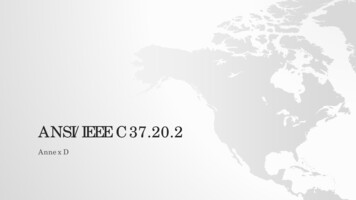
![[ ANSI C37.20 and NEMA SG-5 ]](/img/5/metal-clad-en.jpg)
![[ ANSI C37.20 and NEMA SG-5 ] - tekhar](/img/5/metal-clad.jpg)
